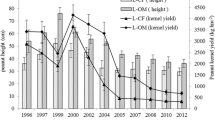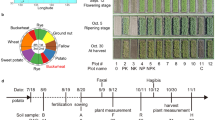Abstract
Microbial communities play a vital role in maintaining soil health. A multiphasic approach to assess the effect of pulp and paper mill effluent on both the structure and function of microbial soil communities is taken. Bacterial communities from agricultural soils irrigated with pulp and paper mill effluent were compared to communities form soils irrigated with well water. Samples were taken from fields in the state of Uttarakhand, India, where pulp and paper mill effluent has been used for irrigation for over 25 years. Comparisons of bacterial community structure were conducted using sequencing of the 16S rRNA gene from both isolates and clone libraries attained from the soil. Community-level physiological profiling was used to characterize the functional diversity and catabolic profile of the bacterial communities. The multiphasic approach using both physiological and molecular techniques proved to be a powerful tool in evaluating the soil bacterial community population and population differences therein. A significant and consistent difference in the population structure and function was found for the bacterial communities from soil irrigated with effluent in comparison to fields irrigated with well water. The diversity index parameters indicated that the microbial community in pulp and paper mill effluent irrigated fields were more diverse in both structure and function. This suggests that the pulp and paper mill effluent is not having a negative effect on the soil microbial community, but in fact may have a positive influence. In terms of soil health, this finding supports the continued use of pulp and paper mill effluent for irrigation. This is however only one aspect of soil health which was evaluated. Further studies on soil resistance and robustness could be undertaken to holistically evaluate soil health in this situation.





Similar content being viewed by others
References
Kibblewhite MG, Ritz K, Swift MJ (2008) Soil health in agricultural systems. Philos Trans R Soc Lond B 363(1492):685–701
Singh BK, Munro S, Reid E, Ord B, Potts JM, Paterson E, Millard P (2006) Investigating microbial community structure in soils by physiological, biochemical and molecular fingerprinting methods. Eur J Soil Sci 57:72–82
Griffiths BS, Bonkowski M, Roy J, Ritz K (2001) Functional stability, substrate utilisation and biological indicators of soils following environmental impacts. Appl Soil Ecol 16(1):49–61
Tiku DK, Kumar A, Sawhney S, Singh VP, Kumar R (2007) Effectiveness of treatment technologies for wastewater pollution generated by Indian pulp mills. Environ Monit Assess 132(1–3):453–466
Tewari PK, Batra VS, Balakrishnan M (2009) Efficient water use in industries: cases from the Indian agro-based pulp and paper mills. J Environ Manag 90:265–273
Udayasoorian C, Prabu PC, Mini K (2004) Influence of composted bagasse pith and treated paper mill effluent irrigation on groundnut. Madras Agric J 91:126–129
Kannan K, Oblisami G (1990) Influence of irrigation with pulp and paper-mill effluent on soil chemical and microbiological properties. Biol Fert Soils 10:197–201
Tripathi BM, Kaushik R, Kumari P, Saxena AK, Arora DK (2011) Genetic and metabolic diversity of streptomycetes in pulp and paper mill effluent treated crop fields. World J Microbiol Biotechnol 27(7):1603–1613
Quirino BF, Pappas GJ, Tagliaferro AC, Collevatti RG, Neto EL, da Silva MRSS, Bustamante MMC, Kruger RH (2009) Molecular phylogenetic diversity of bacteria associated with soil of the savanna-like Cerrado vegetation. Microbiol Res 164:59–70
Weber KP, Legge RL (2010) Community level physiological profiling. In: Cummings SP (ed) Methods in molecular biology: bioremediation. The Humana Press, New Jersey, pp 263–281
Chopra SL, Kanwar JS (1991) Analytical agricultural chemistry, 4th edn. Kalyani Publishers, New Delhi
Jackson ML (1971) Soil chemical analysis. Prentice-Hall, New Delhi
Rhoades JD (1982) Soluble salts. In: Page AL, Miller RH, Keeney DR (eds) Methods of soil analysis, part 2. American Society of Agronomy, Madison, pp 167–179
Pospiech A, Neumann B (1995) A versatile quick-prep of genomic DNA from gram-positive bacteria. Trends Genet 11:217–218
Edwards U, Rogall T, Blocker H, Emde M, Bottger EC (1989) Isolation and direct complete nucleotide determination of entire genes. Characterization of a gene coding for 16S-ribosomal RNA. Nucleic Acids Res 17(19):7843–7853
Thompson JD, Higgins DG, Gibson TJ (1994) CLUSTAL W: improving the sensitivity of progressive multiple sequence alignment through sequence weighting, position-specific gap penalties and weight matrix choice. Nucleic Acids Res 22:4673–4680
Saitou N, Nei M (1987) The neighbor-joining method: a new method for reconstructing Phylogenetic trees. Mol Biol Evol 4:406–425
Tamura K, Dudley J, Nei M, Kumar S (2007) MEGA4: molecular evolutionary genetics analysis (MEGA) software version 4.0. Mol Biol Evol 24:1596–1599
Schloss PD, Westcott SL, Ryabin T, Hall JR, Hartmann M, Hollister EB, Lesniewski RA, Oakley BB, Parks DH, Robinson CJ, Sahl JW, Stres B, Thallinger GG, Van Horn DJ, Weber CF (2009) Introducing mothur: open-source, platform-independent, community-supported software for describing and comparing microbial communities. Appl Environ Microbiol 75(23):7537–7541
Weber KP, Grove JA, Gehder M, Anderson WA, Legge RL (2007) Data transformations in the analysis of community-level substrate utilization data from microplates. J Microbiol Methods 69:461–469
Weber KP, Legge RL (2010) Method for the detachment of culturable bacteria from wetland gravel. J Microbiol Methods 80:242–250
Dhasarathan P, Theriappan P, Ashokraja C (2010) Microbial diversity in firework chemical exposed soil and water samples collected in Virudhunagar district, Tamil Nadu, India. Indian J Microbiol 50(1):46–49
Tripathi M, Vikram S, Jain RK, Garg SK (2011) Isolation and growth characteristics of chromium(VI) and pentachlorophenol tolerant bacterial isolate from treated tannery effluent for its possible use in simultaneous bioremediation. Indian J Microbiol 51(1):61–69
Chandra R, Singh S, Reddy MMK, Patel DK, Purohit HJ, Kapley A (2008) Isolation and characterization of bacterial strains Paenibacillus sp. and Bacillus sp. for kraft lignin decolorization from pulp paper mill waste. J Gen Appl Microbiol 54(6):399–407
Fierer N, Bradford MA, Jackson RB (2007) Toward an ecological classification of soil bacteria. Ecology 88:1354–1364
Fazi S, Amalfitano S, Pernthaler J, Puddu A (2005) Bacterial communities associated with benthic organic matter in headwater stream microhabitats. Environ Microbiol 7:1633–1640
Paliwal V, Puranik S, Purohit HJ (2012) Integrated perspective for effective bioremediation. Appl Biochem Biotech 166(4):903–924
Acknowledgments
This research was conducted with funds provided by the Indian Council of Agricultural Research under Network Project on Application of Microorganisms in Agriculture and Allied Sectors.
Author information
Authors and Affiliations
Corresponding author
Rights and permissions
About this article
Cite this article
Tripathi, B.M., Kumari, P., Weber, K.P. et al. Influence of Long Term Irrigation with Pulp and Paper Mill Effluent on the Bacterial Community Structure and Catabolic Function in Soil. Indian J Microbiol 54, 65–73 (2014). https://doi.org/10.1007/s12088-013-0398-8
Received:
Accepted:
Published:
Issue Date:
DOI: https://doi.org/10.1007/s12088-013-0398-8




